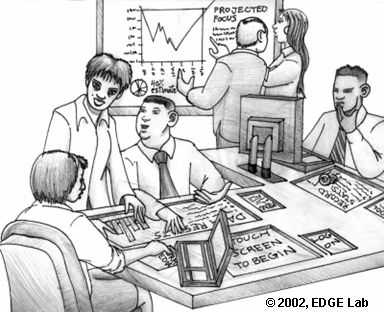What is Computer Supported Cooperative Work (CSCW)? It’s a community. That consists of system builders and behavioural researchers. They examine the way that collaborative behaviour can impact technology and vice-versa. The community itself is fluid and flexible. There’s a formal academic journal that supports their role and two annual conferences in North America and Europe. They generate plenty of academic research, papers, publications, etc. too.
Why CSCW?

Author/Copyright holder: EDGE Lab. Copyright terms and licence: All rights reserved Img source
Back in 1984 Irene Greif was working with Paul Cashman; they held a workshop to try and better understand supportive and collaborative methods of working. They focused on work rather than areas of human interaction because back in 1984 – technology was still incredibly expensive. Most homes didn’t have computers and even of those that did, many didn’t have Internet or other network connectivity to enable collaborative work.
One of the many reasons for the CSCW workshop was a growing frustration with e-mail. E-mail was, in principle at least, a great idea with unlimited potential for generating better support networks and for closer project work in the office. In reality, it wasn’t very good. With no single E-mail standard; each computer vendor had invented their own system and ensured that it would not be compatible with anyone else’s system.
Then the first formal CSCW conference was held in 1986 and brought together design and technology specialists with a vested interest in CSCW. CSCW had a fully open remit to examine collaborative technologies but in general their work tends to reflect the interests of those who participate (a fairly natural consequence of human behaviour in general).
The role of CSCW has evolved over time. Today, technology is so different from back in the 1980s that it could hardly not have forced changes in CSCW’s working practices. Technology is no longer always in the back seat of collaborative work practices; quite often it can take the lead today.
The European side of CSCW has tended to be more focused on theory and academia and the North American side on commercial application.
What Does CSCW do Today?
CSCW has grown and there are many important technology related aspects to their work. The best way to discover what’s going on in the field is to read CSCW – Computer Supported Cooperative Work by Jonathan Grudin (a researcher at Microsoft’s Research – Adaptive Systems and Interaction Group) and Steven Poltrock (a former technical research at Boeing).
Header Image: Author/Copyright holder: Momo54. Copyright terms and licence: Public Domain.
Images: CSSW, Cooperation











